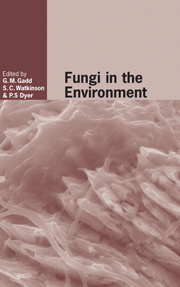Book contents
- Frontmatter
- Contents
- List of contributors
- Preface
- I Imaging and modelling of fungi in the environment
- II Functional ecology of saprotrophic fungi
- III Mutualistic interactions in the environment
- IV Pathogenic interactions in the environment
- V Environmental population genetics of fungi
- 15 Fungal species: thoughts on their recognition, maintenance and selection
- 16 Multilocus sequence typing (MLST) and multilocus microsatellite typing (MLMT) in fungi
- VI Molecular ecology of fungi in the environment
- Index
- References
15 - Fungal species: thoughts on their recognition, maintenance and selection
from V - Environmental population genetics of fungi
Published online by Cambridge University Press: 03 November 2009
- Frontmatter
- Contents
- List of contributors
- Preface
- I Imaging and modelling of fungi in the environment
- II Functional ecology of saprotrophic fungi
- III Mutualistic interactions in the environment
- IV Pathogenic interactions in the environment
- V Environmental population genetics of fungi
- 15 Fungal species: thoughts on their recognition, maintenance and selection
- 16 Multilocus sequence typing (MLST) and multilocus microsatellite typing (MLMT) in fungi
- VI Molecular ecology of fungi in the environment
- Index
- References
Summary
When it comes to fungal species and speciation, it is hard to find anything to say that has not already been said in several excellent recent reviews. The most comprehensive source of information is Burnett's recent book (Burnett, 2003), which expands upon the themes from his British Mycological Society Presidential Address (Burnett, 1983). In addition to reviewing mycological species concepts and speciation, he describes enough about basic mycology and the methodology of evolutionary studies to make chapters on defining fungal individuals and populations, or on the processes of evolution in fungi, useful for mycologists interested in evolution and for evolutionary biologists interested in fungi. Burnett's review of the early literature in fungal speciation is particularly helpful in the present age, when it seems as if literature that is not online is forgotten. A second source of information is Brasier (1997), who explored three of what he considered to be the four main elements contributing to fungal speciation: original interbreeding populations, natural selection on populations and reproductive isolation between populations. He left a discussion of mating systems to others. Brasier's discussion of natural selection is particularly good, and his figure comparing the narrow range of growth rates of dikaryotic hyphae taken from Schizophyllum commune fruiting bodies to the much broader range of growth rates for dikaryons synthesized from their haploid progeny is as clear a demonstration of the effects of selection as one could want.
- Type
- Chapter
- Information
- Fungi in the Environment , pp. 313 - 339Publisher: Cambridge University PressPrint publication year: 2007
References
- 8
- Cited by



